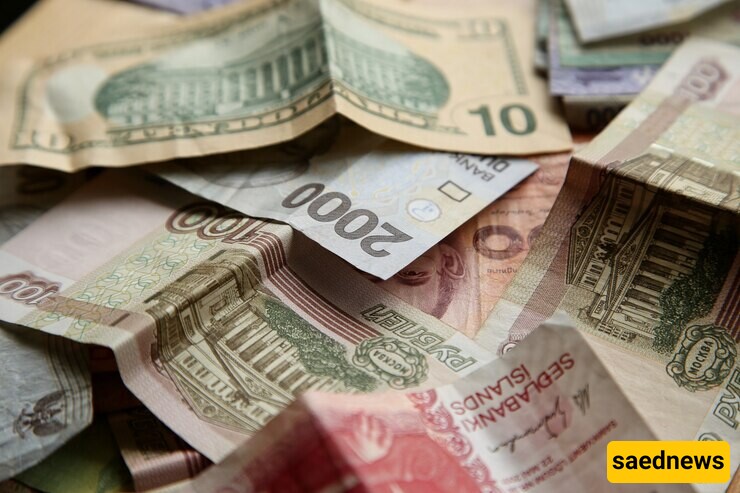SAEDNEWS: Currencies often reflect the culture and history of their time, yet many unique forms of money have vanished over the years. This article explores some intriguing currencies that are no longer in use and the fascinating stories behind them.

According to SAEDNEWS, money serves as more than a medium of exchange; it encapsulates a nation's identity, political history, and economic changes. Over time, numerous currencies have disappeared due to shifting borders, technological advances, or economic crises. This article delves into unique and now-defunct currencies, from bizarre materials used as money to coins and banknotes with captivating stories.

On the Micronesian island of Yap, the currency was neither coins nor notes but massive stone discs called Rai. Some stones were as large as 12 feet in diameter and weighed several tons. Their value was determined by size, craftsmanship, and the journey required to obtain them.
Even though the stones were rarely moved due to their size, ownership was transferred verbally. Rai stones remained a form of symbolic currency until the arrival of modern financial systems. Today, they are historical relics, symbolizing an era when wealth was measured in immovable objects.

The Zimbabwean dollar became infamous in the early 2000s during one of the worst hyperinflation crises in history. Inflation spiraled so out of control that banknotes of absurd denominations, such as 100 trillion Zimbabwean dollars, were issued.
Despite these astronomical figures, the currency lost all practical value, and Zimbabwe eventually abandoned it in 2009, adopting a mix of foreign currencies. The Zimbabwean dollar serves as a reminder of the devastating effects of economic mismanagement and hyperinflation.

Cowrie shells were one of the earliest forms of money, used in parts of Africa, Asia, and the Pacific Islands. Their small size, durability, and aesthetic appeal made them ideal for trade. Cowries symbolized wealth and were even used as dowries in some cultures.
With the advent of coins and paper money, cowrie shells lost their status as currency. However, they remain a fascinating example of how natural resources once served as a medium of exchange.

The Austro-Hungarian Krone was the currency of the Austro-Hungarian Empire from 1892 until its dissolution after World War I. Following the empire’s collapse in 1918, its territories, including Austria, Hungary, and Czechoslovakia, adopted their own national currencies.
The Krone’s downfall reflects the broader political upheaval of the era, as nations sought to establish distinct identities. Today, collectors prize Krone coins and banknotes as remnants of a once-powerful empire.

During the American Civil War, the Confederate States of America issued their own currency to fund the rebellion. Confederate notes featured designs that highlighted Southern pride, including images of slaves, soldiers, and cotton fields.
However, the Confederacy's defeat in 1865 rendered the currency worthless. Today, Confederate money holds value only as a collectible, offering a glimpse into the short-lived Confederate economy.

The Deutsche Mark was introduced in West Germany in 1948, replacing the devalued Reichsmark after World War II. It became a symbol of Germany’s post-war recovery and economic miracle.
In 2002, the euro replaced the Deutsche Mark, but the currency remains a cherished part of German history. Many Germans still refer to prices in marks as a nostalgic nod to its significance.

Tally sticks were used in medieval England as a form of record-keeping and currency. These wooden sticks were split in two, with one half given to the lender and the other retained by the borrower. The two pieces were later reunited to confirm repayment.
Tally sticks fell out of use in the 19th century as paper money and modern banking emerged. Their demise was marked by the catastrophic fire of 1834 at the British Parliament, where excess tally sticks were burned, accidentally destroying much of the building.

The Greek drachma dates back to 500 BCE, making it one of the world’s oldest currencies. It was used during Greece’s golden age, featuring prominently in ancient trade and art.
The drachma was replaced by the euro in 2002 as Greece joined the European Union. Despite its retirement, the drachma remains a symbol of Greek heritage and is still featured in discussions about Greece’s economic history.

Canadian Tire, a popular retail chain in Canada, issued its own store-specific currency in 1958. Customers earned Canadian Tire Money as a loyalty reward, which could be used to purchase items in the store.
Although still accepted in limited circumstances, the rise of digital loyalty programs has made the currency largely obsolete. It remains a quirky example of how private businesses have experimented with unique monetary systems.

The Venetian ducat, introduced in the 13th century, became one of the most trusted currencies in medieval Europe. Made of high-purity gold, the ducat was widely used in international trade and valued for its stability.
The ducat eventually faded as Venice’s influence declined and modern national currencies took its place. Today, it serves as a reminder of Venice’s maritime and economic power during the Middle Ages.
Currencies they tell stories of human creativity, adaptability, and the rise and fall of civilizations. From giant stone discs to hyperinflated banknotes, each defunct currency offers a unique perspective on how societies have valued wealth. While these currencies are no longer in use, they live on as historical artifacts, teaching us about the economic and cultural forces that shaped the world.

